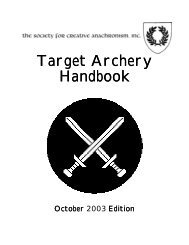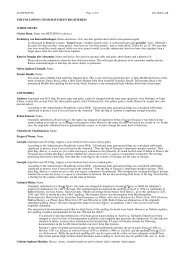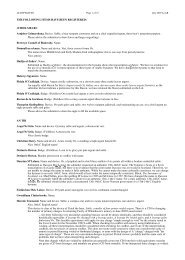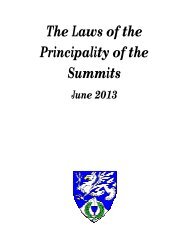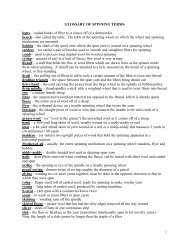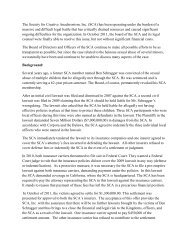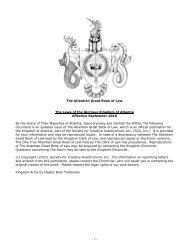The Standards for Evaluation of Names and Armory - SCA Heraldry
The Standards for Evaluation of Names and Armory - SCA Heraldry
The Standards for Evaluation of Names and Armory - SCA Heraldry
You also want an ePaper? Increase the reach of your titles
YUMPU automatically turns print PDFs into web optimized ePapers that Google loves.
A. <strong>Armory</strong><strong>The</strong> <strong>St<strong>and</strong>ards</strong> <strong>for</strong> <strong>Evaluation</strong> <strong>of</strong> <strong>Names</strong> <strong>and</strong> <strong>Armory</strong>:<strong>The</strong> Rules <strong>for</strong> SubmissionsArmorial submissions fit into four categories: primary armory, fielded badges, fieldless badges, <strong>and</strong>augmentations <strong>of</strong> honor. <strong>The</strong> first two follow identical rules <strong>and</strong> are just administrative categories. Primaryarmory refers to the single main armorial device <strong>for</strong> an individual or branch. Fielded badges are similarsecondary items; they may function as badges or as devices <strong>for</strong> alternate personas. Fieldless badges, which can bedisplayed on any background, are more typical <strong>of</strong> period badges. <strong>The</strong>y have some special rules <strong>for</strong> style <strong>and</strong>conflict, discussed in the relevant sections. Augmentations <strong>of</strong> honor are additions to existing pieces <strong>of</strong> primaryarmory to reflect an honor bestowed by the Crown <strong>of</strong> an individual kingdom. See A.3 <strong>for</strong> discussion <strong>of</strong> the ruleswhich apply specifically to augmentations <strong>of</strong> arms. <strong>The</strong>re is no separation between personal armory <strong>and</strong> nonpersonalarmory <strong>for</strong> style, conflict or presumption. <strong>The</strong> Ordinary <strong>and</strong> Armorial contains some other types <strong>of</strong>items, such as flags <strong>of</strong> important non-<strong>SCA</strong> entities; these are also considered armory <strong>for</strong> the purposes <strong>of</strong> conflict<strong>and</strong> presumption.To be registered, an armorial submission must meet the following st<strong>and</strong>ards:- <strong>The</strong> armorial elements, charge groups, <strong>and</strong> overall design must be compatible with period style. Thatmeans demonstrating that it follows the rules in A.2 <strong>and</strong> A.3 or the rules in A.4. A.1 explains how todo this in more detail.- <strong>The</strong> armory must be free <strong>of</strong> conflict <strong>and</strong> presumption as described in A.5 <strong>and</strong> A.6.- <strong>The</strong> armory must not be <strong>of</strong>fensive as described in A.7.A.1. <strong>Armory</strong> Style PrinciplesA. Definitions <strong>of</strong> Rule Sets: We require an armorial submission to be compatible with period armorial content<strong>and</strong> style. We consider a design that follows attested patterns <strong>for</strong> armorial content <strong>and</strong> style within our periodto meet this requirement. <strong>The</strong>re are two ways to follow attested patterns:1. Core Style Rules: Designs that follow the Core Style rules in A.2 <strong>and</strong> A.3 below meet this requirement.<strong>The</strong>se sections comprise our core style. Our core style is not identical to the style <strong>of</strong> any single specificplace <strong>and</strong> time, although it is based on the dominant style in medieval Western Europe, the Anglo-Normanstyle.Some <strong>of</strong> those rules require documentation <strong>of</strong> an element, demonstrating that it is attested or constructed. Insome cases, these rules or the Appendices are sufficient documentation. For example, a submitter mightdemonstrate that a plant was known to period Europeans.Submissions that are documented under the Core Style rules are allowed to have a single step from periodpractice, sometimes denoted as SFPP. In older rulings this same concept was described as a weirdness. Astep from period practice is an element not found in period, core style armory that we nonetheless allow.Some types <strong>of</strong> elements which are designated as a step from period practice are mentioned in the style rules.In addition, a partial list <strong>of</strong> elements that are a step from period practice is found in Appendix F. Anyarmorial submissions with more than one step from period practice will not be registered under the CoreStyle rules.2. Individually Attested Patterns: Designs which follow period examples but do not fall within the corestyle rules in A.2 <strong>and</strong> A.3 may instead meet the style st<strong>and</strong>ards <strong>of</strong> the Individually Attested Pattern rules asexplained in A.4.Under the Individually Attested Pattern rules, all elements (including charges, arrangement, complexity,<strong>St<strong>and</strong>ards</strong> <strong>for</strong> <strong>Evaluation</strong> <strong>of</strong> <strong>Names</strong> <strong>and</strong> <strong>Armory</strong> – April 29, 2012 - Page 35 <strong>of</strong> 73



